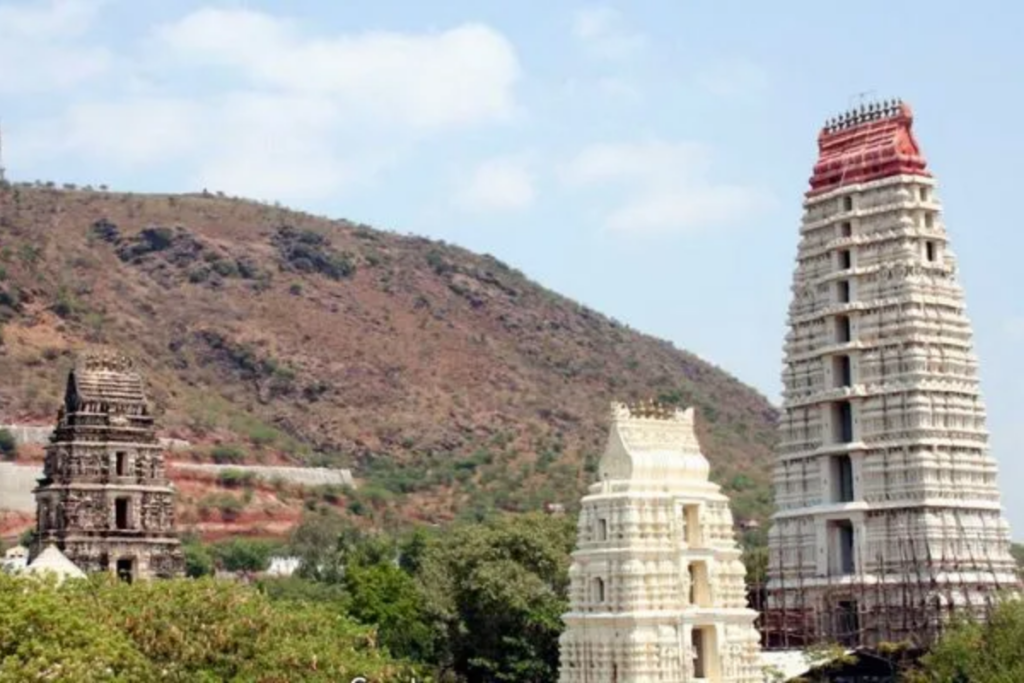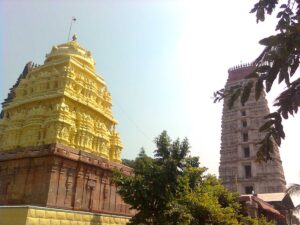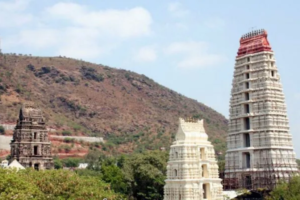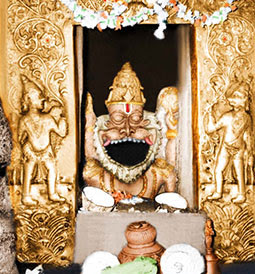Mangalagiri Panakala Swamy Temple:
The Mangalagiri Panakala Swamy Temple is a popular Hindu temple located in the state of Andhra Pradesh, India. The temple is dedicated to Lord Vishnu and is one of the most important temples in the state. The panakala lakshmi narasimha swamy temple is believed to have been built by the great sage Bhrigu, who is said to have performed a great yagna (fire sacrifice) here.
Read other famous temples in Andhra Pradesh
The panakala swamy temple is located on the banks of the Krishna River in a small village called Panakala, about 40 km from the city of Vijayawada. The temple is said to be about 1000 years old and is believed to be one of the oldest temples in the state. The temple is also known for its unique architecture, which features an intricately carved entrance.
The main deity of the temple is Lord Vishnu, who is worshipped in the form of Lord Sri Venkateswara. The temple is also home to several other deities, including Lord Shiva and Goddess Lakshmi.
The temple is a popular pilgrimage site for devotees from all over the world. Every year, thousands of devotees visit the temple to offer their prayers and seek blessings from the Lord. The temple is believed to be a source of immense spiritual energy and blessings for all who visit.
The temple is open all days of the week and special poojas and rituals are conducted on a daily basis. The temple is also popular for its grand festivals, which are celebrated with great pomp and show. The temple is also known for its delicious prasadam (food offerings) served to the devotees.
The Panakala Swamy Temple is a popular and highly revered pilgrimage site that is visited by devotees from all over the world. It is an important spiritual centre in the state of Andhra Pradesh and continues to be a source of immense spiritual energy and blessings for all who visit.
Mangalagiri Panakala Swamy Temple History:
Mangalagiri is Sanskrit for “The Holy Hill,” and there may be a stone pillar with a Telugu inscription at the bottom of the stone steps that records local donations. It was written in AD 1520 and detailed Kondavidu’s seizure from the Gajapathi Raju rulers of Kalinga in 1515 by Timmarusu, a commander of Krishna Deva Raya (ancient Odisha). Another stone close to the Garudalwar temple features inscriptions on four sides that list grants made during Sadasiva Raya’s rule of the Vijayanagara Empire in AD 1538.
In terms of sculpture and design, the temple at the base of the hill was built by “Raja Vasireddy Venkatadri Nayudu” between 1807 and 1809. This temple stands to be the last testament to the traditional vishwakarma sthapathis’ methods of planning and sculpting these temples.
For a long time, the Golconda Nawabs were in charge of this location. Hyder Ali robbed it in 1780, but he was unable to seize it. A Pindari gang pillaged the location once more in 1816. Raja Vasireddy Venkatadri Nayudu, who ruled the region from Amravati, had a gradual recovery after these two assaults.
Sacred Heart of Panakala Lakshmi Narasimha Swamy
This Kshetram is thought to offer “Moksha” with just one visit. Lord Rama went to this temple to find mental and physical tranquillity. He prayed in this Kshetram and gained back what he had lost. According to legend, Lord Rama requested that Anjaneya take up permanent residence here as Kshetra Palaka. The offering of a jaggery-and-water beverage termed naivedya is customary in the shrine. The Panaka Puja is gladly accepted by the Lord when devotees serve this beverage in fulfilment of their vows. To piligrim, Naivedya Panakam is given out as prasad. Another peculiar thing about this place is that there are no insects of any type, even flies.
Laxmi Narasimha Swamy Temple: This temple, also called Sri Lakshmi Narasimha Swamy, is located at the base of the hill. Both the image of Lakshmi Devi on his left and the representation of the Lord as Narasimha (the man-lion) are made of stone. The Lord’s garland, constructed of 108 “Saligramam,” is one of the temple’s noteworthy characteristics. During daily rituals in this temple, a unique conch called “Dakshanavrutha Sankham,” thought to have been used by Lord Krishna, is still employed. The Tanjore gave this conch to the temple as a gift.
Temple of Sri Lakshmi Devi:
A temple dedicated to Sri Lakshmi Devi, Lord Narasimha’s spouse, is located behind the main temple. There is a tunnel here that is supposed to finish at Undavalli on the banks of the River Krishna, to the west of the temple. It was thought that sages would utilise this tunnel to access the River Krishna for bathing.
In terms of sculpture and design, the temple at the base of the hill was built by “Raja Vasireddy Venkatadri Nayudu” between 1807 and 1809. This temple stands to be the last testament to the traditional vishwakarma sthapathis’ methods of planning and sculpting these temples.
The main draw for the Lakshmi Narasimha Swamy temple is the Thoorpu Gali Gopuram (Tower on East Side). Three storeys were built by the Vijayanagara rulers, and a further eight storeys were built by Raja Vasireddy Venkatadri Naidu. This temple is 153 feet tall and 49 feet wide. Towers with less breadth and more height are quite uncommon, like this one. It is the only structure of its kind in this region of India and one of the tallest gopurams in South India.
Panakala Swamy Temple Timings:
Everyday 7am – 4 pm
Morning 07-00 Opening the doors
07-00 to 07-30 Morning Archana
07-30 to 01-00 Special Archana for the devotees and offering Panakam
01-00 Maharnivedana
03-00 Closing the doors
Lakshmi Narasimha Swamy Temple Timings:
Morning 05-00 – Opening the doors
05-30 – Offering the Theertham
06-00 – Morning Archana
07-30 – Ghoshti (Using the theertham offering)
07-30 to 11-00 – Special Archana for the devotees
11-30 – Maharnivedana
12-30 – Closing the doors
Evening 04-00 – Opening the doors
04-00 to 07-00 – Special Archana for the devotees
07-30 – Evening Archana, Harathi, Theertha Ghoshti
08-30 – Closing the doors
Mangalagiri Temple official website – https://www.mangalagiri.org/
Festivals Celebrated at Mangalagiri Panakala Swamy Temple:
Sri Panakala Lakshmi Narasimha Swamy Brahmothsavam is an extremely important annual event. It is believed that Dharmaraja initiated the event at Lord Krishna’s request. Pradyumna, Lord Krishna’s son, requested that his father celebrate his birthday every year for seven days on Phalguna Suddha Sapthami. Lord Krishna handed this task to Dharmaraja, the eldest pandava and the throne’s succession in Hasthinapura.
The event is currently observed for 11 days, beginning with phalguna sudda shasti (February-March). On Chaturdasi, one day before Phalguna Suddha Purnima, Santha Narasimha Swamy’s marriage to Sridevi and Bhoodevi will be commemorated. They observe Agama sastra on these occasions. The Chenchus celebrate the marriage of their daughter Chenchu Lakshmi to Narasimha Swamy before the wedding. Swamy visits Sesha Vahanam and takes part in Eduru Kola that evening. Indians celebrate the Holi festival on Purnima, which falls the day following the marriage. Around a million people, both local and from other locations, gather here to celebrate Tirunalla on the same day. The Lord will ride in a procession on a large chariat, and hundreds of followers will enthusiastically pull this cart.
Other holidays that are widely observed here are Mahasivarathri, Vaikunta Ekadasi, Hanumajayanthi, Narasimhajayanthi, and Srirama Navami. The Lord will ride a miniature chariot in a parade on Mahasivarathri.
How to reach Mangalagiri Panakala Swamy Temple:
The temple is well connected by road and the nearest railway station is Mangalagiri railway station, which is just 2 km away from the temple. The temple can be reached by auto rickshaws and taxis from the railway station.
Vijayawada to Mangalagiri Temple distance – 28 min (15.3 km) via NH16
Guntur to Mangalagiri Temple distance – 45 min (25.3 km) via NH16
mangalagiri temple to undavalli caves distance – 18 min (8.2 km) via Mangalagiri – Rayapudi Rd and Undavalli – Yerrapalem Rd




